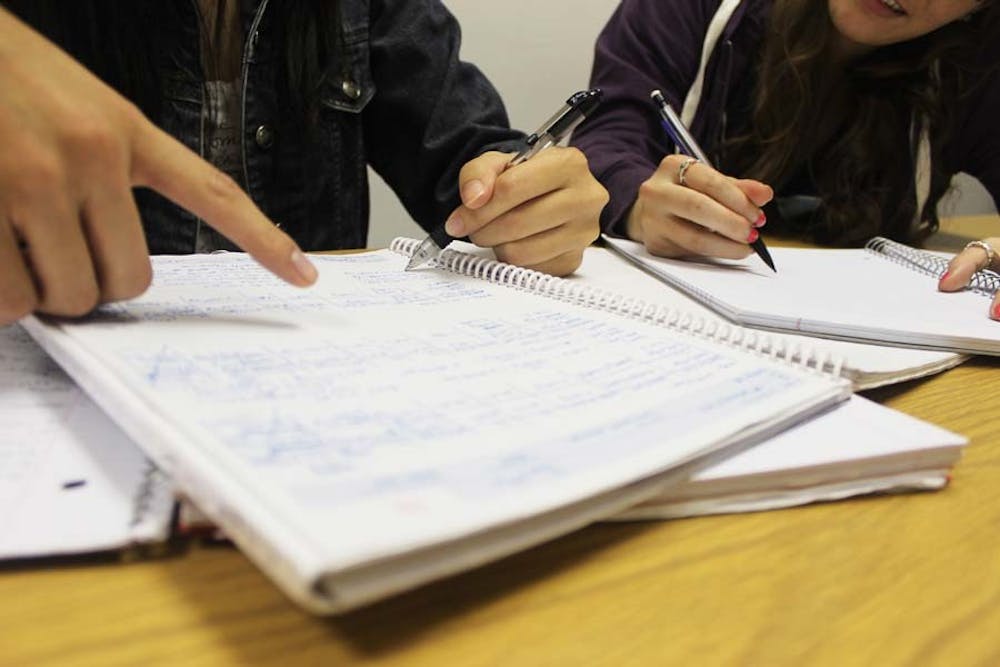
Students collaborate and teach each other during flipped lectures.
Credit: Photo Illustration by Amanda SuarezThere are no rows of students on Facebook or napping in Professor Donald Berry’s Chemistry 101 lecture.
Instead, students are grouped at circular tables discussing and solving problems while Berry and two teaching assistants walk around answering questions.
This section of Chem 101 is one of five experimental STEM classes this semester utilizing the Structured Active in Class Learning method, better known as the “flipped-teaching” method. Bruce Lenthall, executive director of Penn’s Center for Learning and Teaching, describes SAIL as “removing the lecture from the classroom and replacing it with students in [a] highly active environment.”
Instead of learning the content in class, students are expected to do readings or watch lectures on their own, so that class time is spent on “practicing the thinking of the disciplines” rather than basic understanding or memorization, Lenthall said.
“Let’s do the hard stuff when you’ve got the professor and TAs to help you with it, and let’s move the information transfer to another time,” Lenthall added.
Lenthall says that although SAIL is not widespread, research shows that it is a very effective learning method, especially in science, technology and engineering fields.
College freshman Meredith Kline, who is currently enrolled in Berry’s experimental section, agrees. She said that the effectiveness of SAIL “…hit me when we were supposed to do a problem together, and after explaining a problem to someone I understood it better.”
This is not the first semester SAIL is being used in classes. Allison Siegenfeld, a College sophomore, was enrolled in a Chemistry class with Berry last year. She remembers that her table would often get problems where they “had no idea how to begin … It was definitely a lot more of applications of knowledge as opposed to just spitting out facts.”
SAIL is also not solely limited to STEM fields. The Wharton School recently announced that four of its core MBA courses will be taught through Coursera, allowing class time to be devoted to active engagement such as discussions and group activities.
Penn received a $500,000 grant over the summer from the Association of American Universities to improve the quality of STEM education by using SAIL to create more interactive classrooms supported by online lectures.
With this grant, Penn will implement support systems to help create new course materials to go along with this method of teaching. They will also gather data and analyze how effective these courses are.
Although online classes on Coursera are often used to support this new style of teaching, Lenthall says that online lectures are not necessary for the SAIL method. Classes can also be structured so that students research and discover the information they need to know through problem solving in class.
Some faculty members are hesitant to use SAIL in their classes because they worry that it leaves behind weaker students who have difficulties learning independently outside the classroom. “The notion of the flipped classroom isn’t an idea that has a lot of traction here,” Lenthall admits.
However, Berry doesn’t see lecture and SAIL as mutually exclusive. “Personally, I feel there is some value to both formats … and will usually have a mix in any given time period,” he said in an email.
Students also found the social aspect of SAIL rewarding. “You actually bonded with your class because you talked a lot,” College sophomore Jerry Hsu said. The atmosphere in Berry’s class was informal, with students speaking freely with the professor and each other.
Lenthall also said that the independent style of SAIL allows students to own their own education. In contrast to the top-down lecture style, SAIL shows that in learning, “sometimes there are multiple right tracks.”
The Daily Pennsylvanian is an independent, student-run newspaper. Please consider making a donation to support the coverage that shapes the University. Your generosity ensures a future of strong journalism at Penn.
DonatePlease note All comments are eligible for publication in The Daily Pennsylvanian.








